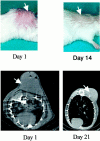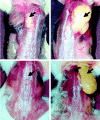Antibody-mediated resolution of light chain-associated amyloid deposits
- PMID: 11021828
- PMCID: PMC1850152
- DOI: 10.1016/S0002-9440(10)64639-1
Antibody-mediated resolution of light chain-associated amyloid deposits
Abstract
Primary light-chain-associated (AL) amyloidosis is characterized by the deposition in tissue of monoclonal light chains as fibrils. With rare exception, this process is seemingly irreversible and results in progressive organ dysfunction and eventually death. To determine whether immune factors can effect amyloid removal, we developed an experimental model in which mice were injected with amyloid proteins extracted from the spleens or livers of patients with AL amyloidosis. Notably, the resultant amyloidomas were rapidly resolved, as compared to controls, when animals received injections of an anti-light-chain monoclonal antibody having specificity for an amyloid-related epitope. The reactivity of this monoclonal antibody was not dependent on the V(L) or C(L) isotype of the fibril, but rather seemed to be directed toward a beta-pleated sheet conformational epitope expressed by AL and other amyloid proteins. The amyloidolytic response was associated with a pronounced infiltration of the amyloidoma with neutrophils and putatively involved opsonization of fibrils by the antibody, leading to cellular activation and release of proteolytic factors. The demonstration that AL amyloid resolution can be induced by passive administration of an amyloid-reactive antibody has potential clinical benefit in the treatment of patients with primary amyloidosis and other acquired or inherited amyloid-associated disorders.
Figures






References
-
- Solomon A, Weiss DT: Protein and host factors implicated in the pathogenesis of light chain amyloidosis (AL amyloidosis). Amyloid. Int J Exp Clin Invest 1995, 2:269-279
-
- Kyle RA, Gertz MA: Primary systemic amyloidosis: clinical and laboratory features in 474 cases. Semin Hematol 1995, 32:45-59 - PubMed
-
- Dhodapkar MV, Merlini G, Solomon A: Biology and therapy of immunoglobulin deposition diseases. Hematol Oncol Clin North Am 1997, 11:89-110 - PubMed
-
- Falk RH, Comenzo RL, Skinner M: The systemic amyloidoses. N Engl J Med 1997, 337:898-909 - PubMed
-
- Gertz MA, Kyle RA: Amyloidosis: prognosis and treatment. Semin Arthritis Rheum 1994, 24:124-138 - PubMed
Publication types
MeSH terms
Substances
Grants and funding
LinkOut - more resources
Full Text Sources
Other Literature Sources
Medical

